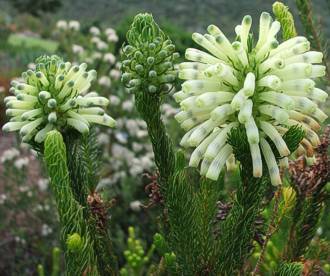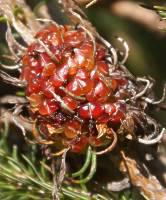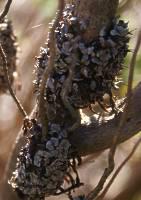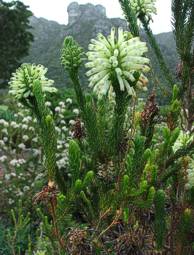Erica sessiliflora
Erica sessiliflora L.f.
Family: Ericaceae
Common names: green heath, white bottlebrush heath (Eng.); groenheide, groenbottelheide (Afr.)
Introduction
Erica sessiliflora has intriguing, pale yellowish green, tube-shaped flowers in showy heads and is a rewarding and decorative garden plant.

Description
Description
Erica sessiliflora is an erect, woody, densely branched, strong-growing shrub, 1-2 m high. The branches are covered in upward-pointing, needle-like leaves. The flowers are pale yellowish green, tubular, 16-30 mm long and curving downward, and are arranged in dense spikes towards the tips of main branches. This spectacular plant is hard to miss when in flower, which takes place all year round (January to December) with a peak during autumn to spring (April to September), although flowering time may vary from locality to locality.

What makes this species different from other ericas, and so easy to recognise, are the knobby protuberances on the stems below the current flower heads. These are not a fungal or viral infection, but the seed capsules, which remain on the plant for many years and are known as fruiting heads. When flowering is over and the flowers shrivel up and die, the sepals remain, grow larger and become hard and fleshy, protecting the ovaries with their developing seeds inside. The fruiting heads are usually yellowish green turning brown, but in one form they are a striking dark red. No other Erica shares this characteristic, it is unique to E. sessiliflora.


Conservation Status
Status
Erica sessiliflora is not threatened; it is widespread.
Distribution and habitat
Distribution description
Erica sessiliflora has a wide distribution range. It occurs from Piketberg in the Western Cape to Humansdorp in the Eastern Cape, and is found in a number of regions in between including the Cape Peninsula, Overberg and along the Garden Route.
It is usually seen on flats and lower mountain slopes, growing in damp to moist places, especially seepage areas, or next to streams, or where there is a lot of water run-off. This indicates that this species does best in cultivation in areas with high precipitation or where it is given water all year round.
Derivation of name and historical aspects
History
The species name sessiliflora means having sessile or unstalked flowers. This is not strictly true of Erica sessiliflora: the flowers do have stalks but they are very short, so the flowers appear to be sessile.
The genus Erica has 860 species of which 770 are confined to southern Africa and most of these are found in the Western and Eastern Cape, making it the largest genus of the Cape Floral Kingdom. Erica species have many colours from pink, white, purple, green, yellow, orange and red, and are found in many different forms, sizes and habitats. Their flowers have many different shapes, from bottle- to globe- to tube- to urn-shaped flowers and more. This may be the reason why this genus is so enticing and can lead to a lifetime of interest.
Ecology
Ecology
The key pollinators of the genus Erica are insects, birds and wind. Erica sessiliflora is pollinated by sunbirds. The sunbird inserts its long, curved beak into the long tube-shaped flower and extracts nectar at the base of the flower, and in turn its beak comes into contact with the pollen on the anthers positioned in the mouth of the flower tube. The bird then transfers the pollen to the stigma of another flower. The flowers are pollinated and seed is produced.
Erica sessiliflora is most unusual among ericas as it is serotinous, i.e. it retains its seed for several years on the bush. The fruiting bodies may stay attached to a branch for up to seven years or until the bush is burnt, whereupon the seed is released. The smoked seeds fall to the ground and germinate in the autumn. Serotiny is an adaptation to survive fire by storing the seeds in a fire-safe environment. Many fynbos species also store their seeds on the bush for many years, but this is the only Erica that does so.
Uses
Use
Erica sessiliflora is not a medicinal or useful plant, but is an excellent garden shrub. It attracts birds to the garden. Its flowers are certainly a joy to admire and are long-lasting in a vase.
Growing Erica sessiliflora
Grow
Plant Erica sessiliflora in full sun, where there is free circulation of air. Soil type should be free-draining, sandy and acidic with low levels of phosphate. No manure should be used, rather feed with well-rotted compost or slow-release or low-dose organic fertilizers. To increase acidity of the soil, decomposed pine needles or pine bark can be mixed into the soil. Remove weeds and grass before planting. Mulch with well-rotted compost or pine bark after planting--this helps suppress weeds and prevents soil moisture from evaporating. If weeds are removed from around the plant, hold the soil down firmly around the weed first and then remove the weed; this helps prevent disturbance to the delicate Erica roots. This plant is not a candidate for the arid water-wise garden as it needs water all year round. The best time for planting is in late summer to autumn (March to May), when the weather is cooler. Prune plants regularly as this stimulates branching and removes diseased material.

Grow Erica sessiliflora in the fynbos garden where it looks very attractive inter-planted with other fynbos species or planted en masse. It is well suited to a region with a Mediterranean climate, and does well in rockeries. E. sessiliflora is also suitable for pot cultivation, which is recommended for gardens in colder climates, as the pot can be moved to a protected position during the cold months. Good drainage is essential.
Erica sessiliflora can be propagated from either cuttings or seed. A larger plant is achieved sooner from cuttings than from seed.
Take cuttings in autumn or spring. Semi-hard wood or heel cuttings are best. A higher percentage of rooting is achieved if a rooting hormone is applied. The recommended medium is equal parts of sifted bark and polystyrene for good aeration. Place the cuttings in a mist unit with bottom heat.
Sow seed in autumn (April-May) in 100 mm deep seed trays. Erica sessiliflora seeds take longer to mature than in most other species, and should be harvested from the fruiting heads that are one or two years old. A higher percentage germination is achieved if the seeds are first treated with Instant Smoke Plus Seed Primer or a similar smoke treatment. The soil medium used should be acidic and well drained (e.g. equal parts of river sand and sifted bark mixed together). Sow seeds thinly and evenly to prevent damping off. This can be done by mixing seed with fine, dry sand before sowing and spreading the sand and seed evenly over the seed tray. Cover with a thin layer of sand after sowing. Water gently and keep the tray moist but not wet and out of direct sunlight and rain. Germination occurs within 1-2 months. When the seedlings are about 10 mm tall, move the tray to a lightly shaded position. Pot up when they are 15-20 mm tall and keep lightly shaded and well watered until hardened off (1-3 months). The young, established plants are then moved into direct sunlight and grown on until large enough to be planted into the garden.
References
- Baker, H.A. & Oliver, E.G.H. 1967. Ericas in southern Africa. Purnell, Cape Town.
- Brown, N. & Duncan, G. 2006. Grow fynbos plants. Kirstenbosch Gardening Series. South African National Biodiversity Institute, Cape Town.
- Kesting, D. & Clarke, H. 2008. Botanical names: what they mean. Wild flowers of the Cape Peninsula. Flora Documentation Programme, Friends of Silvermine Nature Area, Muizenberg.
- Leistner, O.A. (ed.). 2000. Seed plants of southern Africa : families and genera. Strelitzia 10. National Botanical Institute, Pretoria.
- Manning, J. 2007. Field guide to fynbos. Struik, Cape Town.
- Oliver, I. & Oliver, E.G.H. (Ted). 2000. Field guide to the ericas of the Cape Peninsula. Protea Atlas Project, National Botanical Institute, Cape Town.
- Schumann, D., Kirsten, G. & Oliver, E.G.H. 1992. Ericas of South Africa. Fernwood Press, Cape Town.
- Smith, C.A. 1966. Common names of South African plants. Memoirs of the Botanical Survey of South Africa No. 35.
- Van Der Spuy, U. 1971. Die groot tuinboek oor inheemse struike en bome. Tafelberg, Cape Town.
Credits
Liezel Brand and Alice Notten
Kirstenbosch National Botanical Garden
September 2009
Plant Attributes:
Plant Type: Shrub
SA Distribution: Eastern Cape, Western Cape
Soil type: Sandy
Flowering season: Spring, Autumn, Winter, Sporadic/All year
PH: Acid
Flower colour: Green, Yellow
Aspect: Full Sun
Gardening skill: Average
Special Features:
Horticultural zones










Rate this article
Article well written and informative
Rate this plant
Is this an interesting plant?
Login to add your Comment
Back to topNot registered yet? Click here to register.